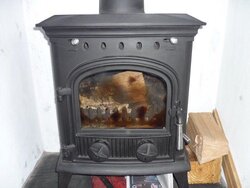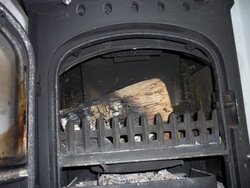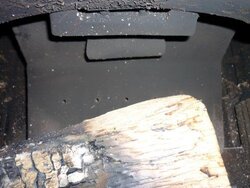Wow. Thanks for everyone taking the time to reply and helping us out like this. Here are some photos of my stove in case that helps. No laughing at how small it is

I also have this link to try to explain the 3-air system I've got :
http://www.stovax.com/images/cms_brochures/60_stovax-stoves.pdf
Unfortunately the diagram I wanted to show you all hasn't come out but the 3-air thing is explained on the right side of page 3.
I'm going to try to respond to everyone in turn. Here goes...
CrappieKeith - I'm pretty sure the draft is good. Light the fire with the door open, nice fire. Close the door, big flames and you can see the draw upwards. Perhaps I will get one of those moisture meters. I wouldn't like to think the wood selling guy was screwing us. We do not have a clothes dryer or an extractor fan. Our double glazing is ancient and draughty. Our living room (where the stove is) is 100 square feet with two doors. These open into the kitchen and the two storey hallway, three bedrooms and a bathroom. We live with all these doors open almost all of the time. I think its a pretty airy house. Circulation is provided by two girls aged 2 and 4 who run and flap all around the ground floor from dawn to dusk despite my protestations. Hopefully, air is not our problem. Thank you for your care and attention though. We'll open a window to rule it out.
Jags - I believe you could be spot on with B and possibly A. We can mostly touch the top of the stove with our bare hands. Seriously bad news, yeah? Yes my friend, primary, secondary and tertiary controls are all adjustable. On the picture of the front of my wee stove the primaries are the two bottom wheels, the secondary is the the silver lever top right and the tertiary is the silver lever top left. Mad (that's irish mad, not American mad: here it means crazy)
Edthedawg - Thank you for converting the measurements to European. I'm an old-fashioned lady and can do inches as well as centimetres, its just farenheit that I need a converter for. I will get myself a thermometer and report to you guys in farenheit. I can set a fire pretty well and it always lights well first time. I think our logs are too big. Your youtube suggestion made me cry with laughter. The 10 hour reload thing is making me jealous though! Our manual was hilarious. This is a Dublin company and the manual said little more than "Put wood in the hole and light it". We'll try closing the other two controls to light it and following your suggestions. I am heartened by your talk of successful burning of rubbish logs.
Savageactor7 - Been trying to get my hands on wood like that, but Northern Ireland is small and famously tree-less. Makes you question my sanity, doesn't it?
Mayhem - We were using pallets only for the first week and still had the blackening and the tar. They seem to be mostly a pine type of wood.
Wood Duck - I'm definitely going to get some very dry wood to try. I'm in County Antrim and if anyone here has a wood pile outside their house I will fall off my sofa with shock. We just don't get that here and most people do not have any kind of real fire. It's all oil or gas-fired central heating here.
BeGreen - We'll try that, hopefully to just rule it out.
Todd - Sounds like the logs are too big. They're 5 or 6 inches. Sometimes they fill the whole fire box. My own stupidity is slowly dawning on me...
KarrieOn - Chimney is masonry and slightly larger than stove outlet but a kit has been fitted to match the two up. We don't have a steel liner and were assured it wasn't needed (just as well as we couldn't afford it!). There is a clear and well fitted rain cap thing outside.
Controlfreak - As you can hopefully see, there is no nice grey colour inside my stove. I'm afraid I wouldn't know which bit is the firebrick if my life depended on it. Yes, looks like wood is probably too big. Will buy one of those spike things. Two logs will then fit in. As for stockpiling wood, did I mention Ireland has a severe shortage of trees? (Yes, I am a fool) My husband's business partner has a neighbour who wants rid of a load of ash trees so if we could just get a lorry and a chainsaw... Will hunt for proper dry wood this weekend.
A huge thank you to all of you. It is very much appreciated. We will try all of these suggestions and report back to you. This is the best help ever! If I manage to get a good fire going, I'll post a pic.
Thanks again
lorskimac



 !
!

